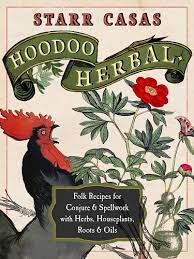Starr Casas is well known for her traditional teaching on conjure and if you want to learn how it's been done for generations, she's one of the teachers to seek out. Her personality comes across in her writing and she says what she thinks. She's Southern, traditional, and she doesn't like what she sees as outside influences changing the way old style conjure is practiced. For her, hoodoo is part of the fabric of daily Southern rural life. In Hoodoo Herbal, she puts the attention back on the plants, roots and herbs that are essential to the work and shares some ways to use them that you won't find printed anywhere else. Although the material is not difficult to understand, it's intended more for those who are already at least passingly familiar with hoodoo. Casas writes with an eye to the legacy of hoodoo and to what she leaves for future students so that this way of life will not be lost.
Casas is concerned that the agricultural roots of the practice are being forgotten as fewer people live with gardens and pass the knowledge on so she shares her family's practices that she grew up with. Knowing that a lot of people don't have more than a houseplant, she offers many works using common houseplants. She lists the houseplants her family taught her to use and explains how you can utilize them. The book provides some information on the practical aspects of gardening, such as seed planting, and transplanting but would not be considered a gardening book as it focuses mainly on folk magic practices.
Casas provides a lot of information on the plants and herbs used in the Bible and references specific Biblical passages and quotes them. She walks the reader through how to bless, and feed roots and herbs before working with them. The chapter on common herbs describes herbs as hot or cool or dual and describes each one's use. Herbs are used for love, money, healing, peaceful home for example. The next chapter on Conjure herbs is also laid out alphabetically and explains whether an herb is used for attraction or money or protection,etc. Once the herbs are introduced, Casas shares 5 of her recipes for conjure oils. Casas own work calls on Jesus and not just the Old Testament. In the following chapters she offers up many more instructions for recipes and prayers for uncrossing, justice, removing, hot foot, success among others. In addition to the herbs, roots, plants and oils, powders and washes are introduced. There is one chapter covering herbal remedies. Some of the information contained is for historical preservation and not recommended now such as the remedy for a teething baby that starts with a warning. The conjure worker's first aid kit is the kind of practical information that practioners may not find in other sources.
There are moments when the book veers out of plants. For instance, a chapter on curios, tools and non-plant ingredients from lucky rabbit’s paw to pins and needles offers a go to guide for items used in conjure. Sections on different types of dirt and different kinds of water, are also probably not what readers of an herbal expect but do provide valuable information on the practice. Prayers and Petitions is a chapter that is less about plants and more about how the Bible is a guide for conjure. Probably the most extraordinary section is the complex set of instructions from Exodus on how to make a holy robe used in Temple. It's highly unlikely most conjure workers will attempt it as the cost of materials alone would be prohibitive. I wondered what Casa's thought process was. Old Testament magic is done publicly, was highly formal and sponsored by Kingdom and Temple making it well beyond the means of the common person. Perhaps she just wanted to share this overlooked passage on the way the ancestors worked and how integral the work was to some figures in the Bible. Perhaps she is saying, this is the root of our practice.
Highly recommended.
~review by Elsie Smyte
Author: Starr Casas
Red Wheel/Weiser
256 pages, $19.95
Hoodoo Herbal: Folk Recipes for Conjure & Spellwork with Herbs, Houseplants, Roots, & Oils

©
2010 - 2025
Facing North
